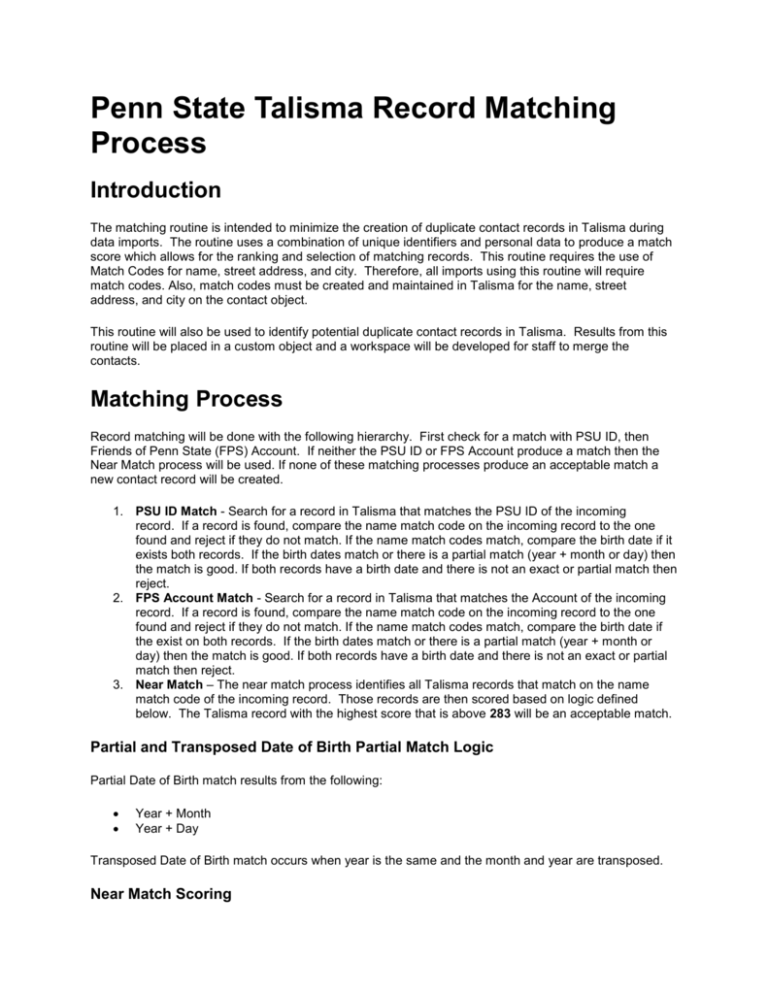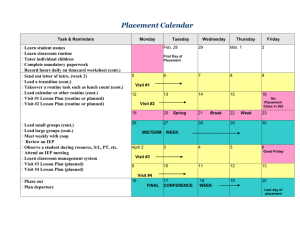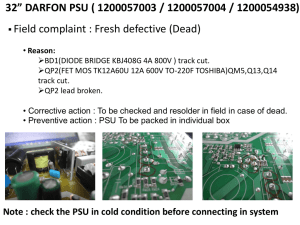near Match Logic
advertisement

Penn State Talisma Record Matching Process Introduction The matching routine is intended to minimize the creation of duplicate contact records in Talisma during data imports. The routine uses a combination of unique identifiers and personal data to produce a match score which allows for the ranking and selection of matching records. This routine requires the use of Match Codes for name, street address, and city. Therefore, all imports using this routine will require match codes. Also, match codes must be created and maintained in Talisma for the name, street address, and city on the contact object. This routine will also be used to identify potential duplicate contact records in Talisma. Results from this routine will be placed in a custom object and a workspace will be developed for staff to merge the contacts. Matching Process Record matching will be done with the following hierarchy. First check for a match with PSU ID, then Friends of Penn State (FPS) Account. If neither the PSU ID or FPS Account produce a match then the Near Match process will be used. If none of these matching processes produce an acceptable match a new contact record will be created. 1. PSU ID Match - Search for a record in Talisma that matches the PSU ID of the incoming record. If a record is found, compare the name match code on the incoming record to the one found and reject if they do not match. If the name match codes match, compare the birth date if it exists both records. If the birth dates match or there is a partial match (year + month or day) then the match is good. If both records have a birth date and there is not an exact or partial match then reject. 2. FPS Account Match - Search for a record in Talisma that matches the Account of the incoming record. If a record is found, compare the name match code on the incoming record to the one found and reject if they do not match. If the name match codes match, compare the birth date if the exist on both records. If the birth dates match or there is a partial match (year + month or day) then the match is good. If both records have a birth date and there is not an exact or partial match then reject. 3. Near Match – The near match process identifies all Talisma records that match on the name match code of the incoming record. Those records are then scored based on logic defined below. The Talisma record with the highest score that is above 283 will be an acceptable match. Partial and Transposed Date of Birth Partial Match Logic Partial Date of Birth match results from the following: Year + Month Year + Day Transposed Date of Birth match occurs when year is the same and the month and year are transposed. Near Match Scoring The near match score is calculated by adding points for a positive match or subtracting points for a mismatch on individual data elements or combinations of data elements. The data elements used in the near match are name match code, street address match code, city match code, two character state code, zip 5, province, country, phone number, email address, gender and high school code. The resulting near match score will rank the matches between the incoming record and existing records in Talisma with higher scores being better matches. All matches on name match code begin with a base score of 150. The following matching rules will add or subtract additional points. Match Scoring Points street match code + 45 city match code + 20 state + 16 province + 16 US zip 5 + 51 international zip + 25 country +7 date of birth exact + 85 partial or transposed date of birth + 35 date of birth mismatch - 300 phone + 97 email + 100 High School + 50 gender mismatch and first name spelling mismatch -5






